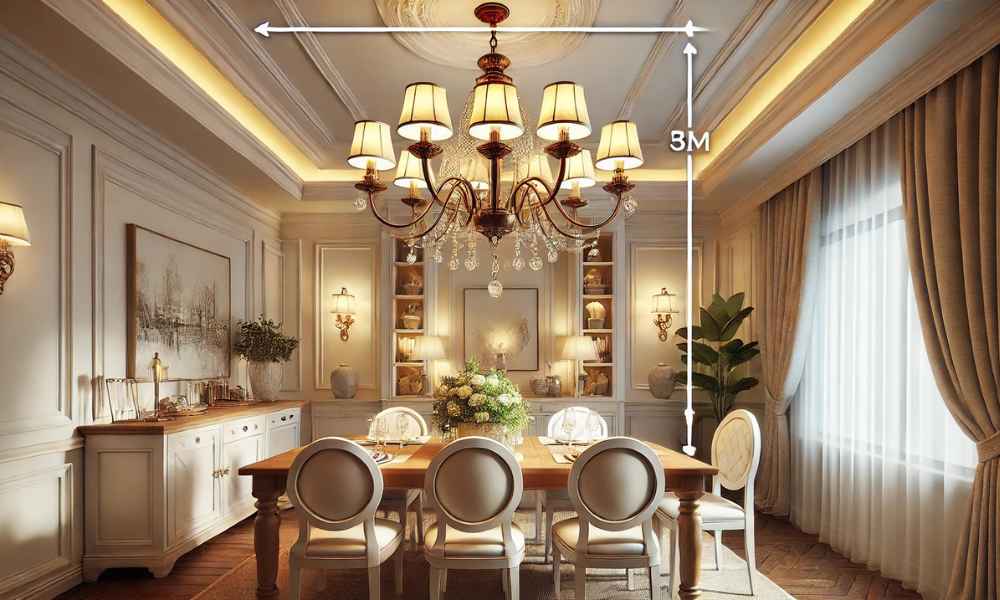A well-placed chandelier does more than just illuminate a dining space—it sets the tone, enhances ambiance, and adds a touch of elegance. However, achieving the perfect chandelier height above your dining table requires more than mere estimation. A fixture hung too high can make the space feel disjointed, while one hung too low may obstruct views and create an overwhelming presence. Understanding the nuances of chandelier placement is essential to ensure a harmonious dining experience, blending functionality with aesthetic appeal. Hang Chandelier Above Dining Table.
The Golden Rule: Ideal Height for Hanging a Chandelier
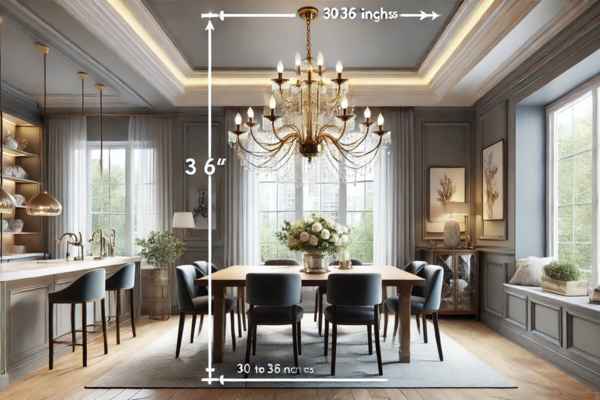
Interior designers follow a general rule of thumb when determining how high to hang a chandelier above a dining table. The standard recommendation is to suspend the fixture 30 to 36 inches above the tabletop when the ceiling height is 8 feet. For taller ceilings, the chandelier should be raised by an additional 3 inches per foot. This ensures that the light is properly distributed across the table while maintaining visual balance.
Beyond measurements, the scale and style of the chandelier play a pivotal role. A grand, oversized fixture may need slight height adjustments to avoid overpowering the space. Whereas a minimalist design might benefit from being slightly lower to enhance intimacy. Ensuring the chandelier is proportionate to the table size further refines the placement, preventing visual clutter.
Factors That Influence Chandelier Height
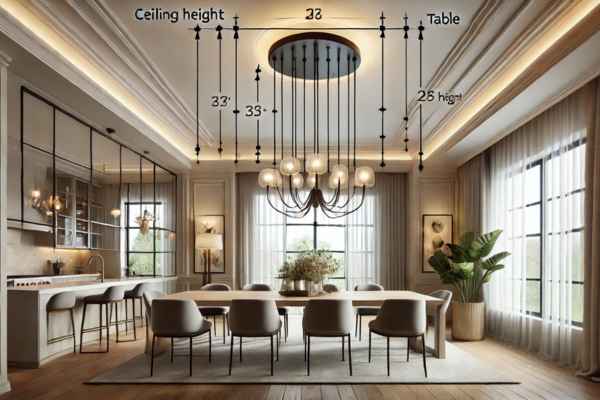
While the golden rule serves as a reliable guideline, several factors may necessitate adjustments:
- Ceiling Height: Higher ceilings demand a greater distance between the table and the chandelier to maintain proportionality.
- Table Dimensions: A long or wide table may require a lower placement for sufficient illumination, while a smaller table can accommodate a slightly higher fixture.
- Fixture Design: Chandeliers with an open, airy design can be positioned lower. Whereas those with dense structures might need to be raised slightly.
- Light Dispersion: The brightness and direction of light should be considered. A chandelier that emits light downward may be hung slightly higher, whereas an all-encompassing glow benefits from a lower placement.
- Room Layout: In open-concept dining spaces, chandelier height should harmonize with adjacent lighting fixtures to create a cohesive look.
Customizing the Height for Different Dining Styles
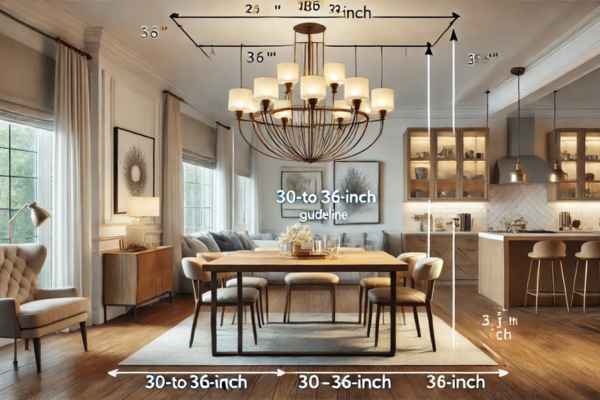
Dining spaces vary in formality and function, requiring a tailored approach to chandelier height:
- Casual Dining Areas: A slightly lower placement fosters a warm, inviting atmosphere, making the space feel intimate.
- Formal Dining Rooms: Precision is key—adhering to the 30- to 36-inch guideline ensures an elegant, balanced aesthetic.
- Multipurpose Spaces: If the dining table doubles as a workspace or social hub. An adjustable chandelier height (via a chain or pulley system) offers flexibility.
- Open Floor Plans: The chandelier should align visually with nearby lighting to maintain a sense of unity across connected spaces.
Measuring and Installing the Chandelier
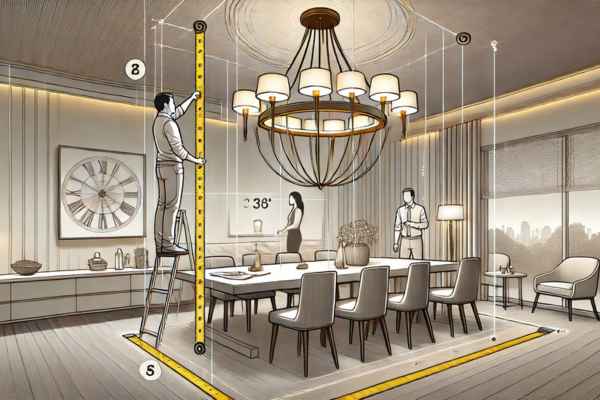
Achieving the perfect height starts with accurate measurements. Follow these steps:
- Measure Ceiling Height: Determine the total ceiling height to assess how much adjustment is needed beyond the standard 30- to 36-inch range.
- Find the Center Point: Position the chandelier directly above the table’s midpoint for symmetrical alignment.
- Account for Chain or Rod Length: Most chandeliers come with adjustable chains or rods—choose the right length to achieve the desired height.
- Test Before Finalizing: Temporarily hold the fixture in place to gauge its visual impact before securing it permanently.
- Ensure Electrical Safety: If modifying the height significantly, consult an electrician to confirm the wiring accommodates the placement.
Adjusting Chandelier Height for Different Ceiling Types

Different ceiling designs require modifications to standard hanging guidelines:
- Standard Ceilings (8-9 feet): The traditional 30- to 36-inch guideline applies.
- High Ceilings (10+ feet): Raise the fixture by an additional 3 inches per extra foot of ceiling height.
- Vaulted or Sloped Ceilings: Use an angled mounting adapter or an adjustable chain to maintain proper positioning and balance.
- Low Ceilings: Consider a flush-mount or semi-flush fixture to avoid excessive height while maintaining illumination.
Choosing the Right Chandelier for Your Dining Table

Beyond height, selecting the right chandelier style and size enhances the dining experience:
- Fixture Diameter: The chandelier should be about half to two-thirds the width of the table for proportional balance.
- Style Alignment: A modern chandelier suits contemporary spaces, while a classic crystal fixture complements traditional decor.
- Layered Lighting: Combining the chandelier with sconces or recessed lighting ensures even illumination.
- Bulb Considerations: Opt for dimmable LED bulbs to create a versatile ambiance for different occasions.
Lighting Considerations Beyond Height
While the correct hanging height is essential, other lighting factors play a significant role in perfecting your dining room’s atmosphere. The type of bulbs you use, the brightness level, and the direction of light all contribute to the overall effect. Soft white or warm LED bulbs are ideal for creating a cozy, intimate feel, while daylight bulbs may be too harsh for dining settings. Dimmers are an excellent addition, allowing you to adjust the brightness according to different occasions—whether it’s a romantic dinner, a lively family gathering, or a casual brunch.
Another key consideration is the spread of light. Chandeliers with exposed bulbs can create harsh shadows, whereas those with diffusers or frosted glass shades provide a softer, more even glow. Additionally, if the chandelier serves as the primary light source, pair it with wall sconces, recessed lighting, or floor lamps to balance the brightness across the room.
Making Adjustments Over Time
Even after installation, you may find that your chandelier’s height isn’t quite right. Over time, as your furniture arrangement changes or your lighting preferences evolve, you might need to adjust its position. If the chandelier feels too overpowering or casts unflattering shadows, raising it slightly can help disperse the light more evenly. Conversely, if the room feels too dim or disconnected, lowering the fixture by a few inches can create a more cohesive look.
Seasonal decorations or different dining setups may also require height modifications. For example, if you frequently decorate with a tall centerpiece, you may need to raise the chandelier slightly to avoid obstruction. On the other hand, if you swap to a smaller dining table, a slightly lower position might enhance intimacy and balance.
Bonus Tips for a Flawless Dining Room Setup
Beyond height and lighting, achieving a beautifully designed dining area involves a few extra considerations. First, ensure your chandelier is proportional to the table—it should be about half to two-thirds the width of the table for a balanced look. Additionally, placing a mirror or glossy surfaces near the fixture can amplify light and add depth to the room.
Another pro tip is to coordinate the chandelier with other decor elements. If your dining room features metallic accents, a fixture with similar finishes can create a cohesive aesthetic. Similarly, the style of the chandelier should complement the overall theme—whether it’s modern, rustic, or classic. Lastly, don’t overlook the importance of maintenance. Regularly dusting the fixture and occasionally checking for loose screws or wiring ensures it stays in top condition for years to come.
What If My Chandelier Chain is Too Short or Too Long?
A common challenge homeowners face is dealing with an ill-fitted chandelier chain. If the chain is too short, it may keep the fixture at an awkward height, making it difficult to achieve the ideal placement. In such cases, you can add chain extenders or additional downrods to lengthen the fixture and ensure a well-proportioned look.
On the other hand, if the chain is too long and the chandelier hangs too low, you might need to remove extra links or shorten the wiring. For safety and aesthetic reasons, it’s best to have an electrician handle this adjustment if you’re unsure. Additionally, if your chandelier features an adjustable cord rather than a chain, using a ceiling hook to loop the excess length can help refine the positioning without altering the fixture itself.
How Do I Center the Chandelier Over an Off-Center Table?
One of the most common design dilemmas homeowners face is dealing with an off-center dining table. In some cases, a light fixture may be pre-wired in the center of the room, but if the dining table is not placed directly underneath, the chandelier may look awkwardly positioned. There are several ways to address this without extensive rewiring. A simple solution is using a swag hook to slightly shift the chandelier’s position while keeping the electrical source intact. This allows you to visually align the fixture with the table while maintaining a clean look.
Alternatively, a chandelier with an adjustable cord or chain provides flexibility in positioning. For a more polished look, an electrician can move the electrical box to permanently center the chandelier over the table. Another design trick involves installing multiple smaller pendant lights or a linear chandelier to create balance, even if the main fixture isn’t perfectly centered. By strategically placing complementary lighting—such as wall sconces or floor lamps—you can create an even distribution of light across the dining space, minimizing the effect of an off-center chandelier.
Should the Chandelier Align with the Table or the Room?
The short answer: always align the chandelier with the table, not the room. Since the dining table is the focal point, the light fixture should complement it rather than the room’s overall dimensions. Even if your dining space is part of an open-concept layout or has asymmetrical features, position the chandelier directly above the center of the table to ensure visual harmony. If you install the chandelier based on room centering rather than table positioning, the dining space may feel disjointed.
A misaligned fixture can create an imbalanced look, especially if the table is placed against a wall or in an unconventional spot. If shifting the electrical wiring isn’t an option, consider adjusting the table placement slightly to bring it under the chandelier or incorporating additional light sources to even out the space. For long rectangular tables, a linear chandelier or a series of pendant lights works best, as it follows the table’s shape and provides consistent illumination. If your table size changes frequently (e.g., extendable dining tables), opt for a chandelier with dimmer settings so you can control the light intensity, making it adaptable for different layouts and occasions.
Conclusion
Finding the perfect chandelier height above a dining table is about more than just measurements—it’s about creating the right ambiance and ensuring practical functionality. While the general rule suggests hanging a chandelier 30 to 36 inches above the table, factors such as ceiling height, table size, and overall room design play a role in final placement. If your table is off-center, adjusting the chandelier’s position with a swag hook, adjustable chain, or multiple light fixtures can help restore balance without requiring major electrical work. Always prioritize table alignment over room symmetry to maintain a visually appealing and functional dining setup.
